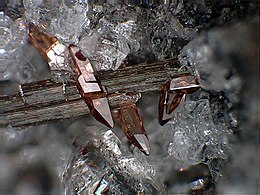
Back تيتانيت Arabic Тытаніт Byelorussian টাইটানাইট Bengali/Bangla Titanita Catalan Titanit Czech Titanit German Τιτανίτης Greek Titanita Spanish Titaniit Estonian Titanita Basque
| Titanite (Sphene) | |
|---|---|
 Titanite crystals on amphibole (image width 2 mm) | |
| General | |
| Category | Nesosilicate |
| Formula (repeating unit) | CaTiSiO5 |
| IMA symbol | Ttn[1] |
| Strunz classification | 9.AG.15 |
| Crystal system | Monoclinic |
| Crystal class | Prismatic (2/m) (same H–M symbol) |
| Space group | P21/a |
| Unit cell | a = 7.057 Å, b = 8.707 Å c = 6.555 Å; β = 113.81°; Z = 4 |
| Identification | |
| Colour | Reddish brown, brown, gray, black, yellow, green, or red, colourless |
| Crystal habit | Flattened wedge-shaped crystals, also massive |
| Twinning | Contact and penetration on {100}, lamellar on {221} |
| Cleavage | Distinct on [110], parting on {221} |
| Fracture | Sub-conchoidal |
| Mohs scale hardness | 5–5.5 |
| Luster | Sub-adamantine tending to slightly resinous |
| Streak | Reddish white |
| Diaphaneity | Translucent to transparent |
| Specific gravity | 3.48–3.60 |
| Optical properties | Biaxial (+); very high relief |
| Refractive index | nα = 1.843–1.950 nβ = 1.870–2.034 nγ = 1.943–2.110 |
| Birefringence | δ = 0.100–0.160 |
| Pleochroism | Strong: X = nearly colorless; Y = yellow to green; Z = red to yellow-orange |
| 2V angle | 17–40° (measured) |
| Dispersion | r > v strong |
| Other characteristics | |
| References | [2][3][4][5] |

Titanite, or sphene (from Ancient Greek σφηνώ (sphēnṓ) 'wedge'),[5] is a calcium titanium nesosilicate mineral, CaTiSiO5. Trace impurities of iron and aluminium are typically present. Also commonly present are rare earth metals including cerium and yttrium; calcium may be partly replaced by thorium.[6]
- ^ Warr, L. N. (2021). "IMA–CNMNC approved mineral symbols". Mineralogical Magazine. 85 (3): 291–320. Bibcode:2021MinM...85..291W. doi:10.1180/mgm.2021.43. S2CID 235729616.
- ^ "Titanite". Handbook of Mineralogy (PDF).
- ^ Titanite Mineral Data, WebMineral.com
- ^ Titanite, Mindat.org
- ^ a b Dana, James Dwight; Ford, William Ebenezer (1915). Dana's Manual of Mineralogy for the Student of Elementary Mineralogy, the Mining Engineer, the Geologist, the Prospector, the Collector, Etc (13 ed.). John Wiley & Sons, Inc. pp. 299–300. Retrieved 2009-07-06.
- ^ Deer, W. A.; Howie, R. A.; Zussman, J. (1966). Introduction to the Rock-Forming Minerals. Longman. pp. 17–20. ISBN 0-582-44210-9.